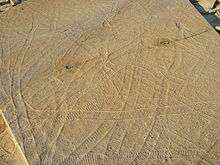Climactichnites
| Climactichnites Temporal range: Middle Cambrian–Late Cambrian | |
|---|---|
 | |
| | |
| Trace fossil classification | |
| Ichnogenus: | †Climactichnites |
Climactichnites is an enigmatic, Cambrian fossil formed on or within sandy tidal flats around 510 million years ago. It has been interpreted in many different ways in the past, but is now known to be a trace fossil of a slug-like organism, thought to have moved by crawling to on-shore surfaces, or near-shore, or burrowing into the sediment.
Morphology
There are two species within this ichnogenus, C. wilsoni and C. youngi. C. wilsoni consists of paired lateral ridges between which are undulating bars and furrows oriented at an angle to the direction of travel, whereas C. youngi lacks the paired lateral ridges and consists only of undulating transverse bars and furrows.[1] An additional trace fossil, called Musculopodus, is sometimes found at the beginning of Climactichnites trails and represents the body imprint of the animal while it was stationary.[2] Climactichnites range from 0.8 to 30 cm wide and may exceed ten feet long, making Climactichnites by far the largest Cambrian trace fossil.[2] Based on measured ratios of Musculopodus imprints, the animal itself is estimated to have reached 69 cm long.[2]
Occurrence
Currently, Climactichnites is known only from North America (Missouri, New York, and Wisconsin in the United States, and Quebec and Ontario in Canada), portions of which were submerged under a shallow equatorial sea during the Cambrian Period.[2] The fossil is found in fine- to coarse-grained sandstones which represent sandy, intertidal beach deposits.[2] Microbial mats probably enabled the trace to be preserved.[2]
Interpretation
Early attempts to interpret the fossil as the body of an alga or siphonophore are easily falsified. Climactichnites is now thought to represent the trail of an organism moving on top of or through the sediment.[2] The animal apparently had a muscular foot and moved by extending either side of its body alternately (sometimes both sides may have been extended in unison) to produce the v-shaped transverse bars.[2] Certainly the animal lacked any appendages, as is evidenced by cross-cutting relationships of the trail with sedimentary structures such as ripple marks.[2] While the identity of the trace-maker remains conjectural, Climactichnites was most likely produced by a large slug-like mollusc; modern gastropods have been observed to produce similar traces.[2] Since it is often associated with surface-produced sedimentary structures, it may have been produced by one of the earliest animals to move about on land.[3] The binding effect of microbial mats on the sediment surface is believed to have contributed to the exceptional preservation of Climactichnites trails.[2][4]
References
- ↑ Getty, P. R.; Hagadorn, J. W. (2008). "Reinterpretation of Climactichnites Logan 1860 to Include Subsurface Burrows, and Erection of Musculopodus for Resting Traces of the Trailmaker". Journal of Paleontology. 82 (6): 1161–1172. doi:10.1666/08-004.1.
- 1 2 3 4 5 6 7 8 9 10 11 Getty, P. R.; Hagadorn, J. W. (2009). "Palaeobiology of the Climactichnites tracemaker". Palaeontology. 52 (4): 753–778. doi:10.1111/j.1475-4983.2009.00875.x.
- ↑ MacNaughton, R. B.; Cole, J. M.; Dalrymple, R. W.; Braddy, S. J.; Briggs, D. E. G.; Lukie, T. D. (May 2002). "First steps on land: Arthropod trackways in Cambrian-Ordovician eolian sandstone, southeastern Ontario, Canada". Geology. 30 (5): 391–394. Bibcode:2002Geo....30..391M. doi:10.1130/0091-7613(2002)030<0391:FSOLAT>2.0.CO;2. ISSN 0091-7613.
- ↑ Getty, P. R. (2006). "Producing And Preserving Climactichnites". Geological Society of America Abstracts with Programs. 38 (7): 475. Retrieved 2008-06-02.
- Yochelson, E. L. and M. A. Fedonkin (1993). "Paleobiology of Climactichnites, and Enigmatic Late Cambrian Fossil" (Free full text). Smithsonian Contributions to Paleobiology. 74: 1–74. doi:10.5479/si.00810266.74.1.
- Getty, P. R., and J. W. Hagadorn, 2006. Producing and preserving Climactichnites. Geological Society of America Abstracts with Programs, v. 38, p. 475.
- P. R. Getty (2007). "Paleobiology of the Climactichnites Trackmaker: An Enigmatic Late Cambrian Animal Known Only from Trace Fossils" (masters thesis).
External links
| Wikimedia Commons has media related to Climactichnites. |
- "Blackberry hill lagerstatte" (in Italian).
- Includes additional photographs and information on Climactichnites from the exceptional Blackberry Hill localities.
- Cambrian jellyfish, Climactichnites and arthropod tracks
- Discusses a major source of Climactichnites trackways. With useful photograph slideshow.